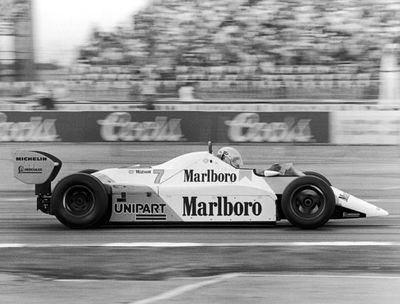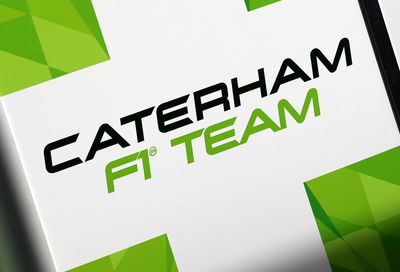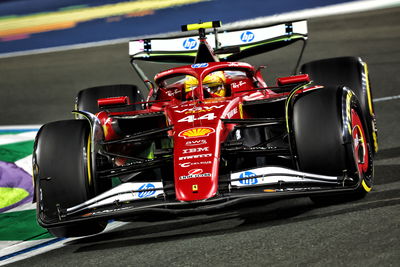F1: In memory of ... The Caesars Palace Grand Prix

With the United States Grand Prix now firmly established in Austin, Formula One has its most entrenched home in the US since the heyday of Watkins Glen.
The history of Formula One in the US is a patchwork tapestry though; a legacy of tentative footholds tainted by circumstance (Watkins Glen, Indianapolis) and half-baked follies around concrete jungles (Detroit, Dallas, Phoenix).
Perhaps Formula One's most bizarre foray in the US came in the early 80s, with a Grand Prix in Las Vegas run around a makeshift circuit in the car park of the Caesars Palace casino. Given recent statements by Bernie Ecclestone linking Formula One with a return to Vegas, the ringmaster would do well to heed the lessons from the sport's last sortie to Sin City.
FROM THE GLEN TO THE STRIP
Formula One's perennially awkward relationship with the United States was in bloom in the late 1970s. Watkins Glen provided an autumnal end of season garden party among the fall foliage of upstate New York, and a street race in Long Beach offered a glamorous early-season counter-point as the 'Monaco of the US' in sunny Southern California.
However, by the end of the decade the Glen was tarnished by enduring safety concerns, outdated facilities and rowdy fans, and amid mounting debts the race was cancelled ahead of the 1981 season. The loss of the Glen after 22 years was an opportunity for Formula One to expand its offering in the States to new frontiers, and Vegas, which had been a non-starter in 1980, was confirmed as a second west coast race to close the 1981 season.
The Vegas of the early 1980s was far from the self-styled Entertainment Capital of the World we know it as today though. Stuck somewhere between the 50s glamour of the Rat Pack era and the mega-casino reinvention of the 90s, Las Vegas was a mostly tired collection of faded glories and crumbling facades. Caesars Palace was the largest and most prominent casino hotel on The Strip, and had infamously played host to failed motorcycle stunts by Evil Knievel and Gary Wells. In spite of this dubious motorsport heritage the resort happily stumped up the race fee, and the vast desert of concrete and sand that made up the Caesars Palace car park was transformed into a Grand Prix circuit.
"CANYONS OF CONCRETE"
Constrained by the tight confines of the Caesars Palace perimeter, the circuit was a bizarre-looking sequence of three repeating 'fingers', a short, flat point and squirt 2.2 mile anti-clockwise sequence of 14 turns winding around a crooked 'M' shape.
Although the track surface was relatively smooth, the circuit's anti-clockwise configuration caused significant problems for the drivers - leading to a common complaint of 'Las Vegas neck'. Combined with the dry desert heat, the Caesars Palace circuit became an ultimate endurance test for a generation of drivers whose notions of diet and fitness were far removed from the standards taken for granted today.
John Watson memorably described the circuit as "a racetrack made up of canyons of concrete", and the high average speed of over 100 mph failed to alleviate the boredom for drivers as the course repeatedly doubled back on itself to make the best use of the available space. The circuit was as uninspiring for spectators and television viewers as it was for the drivers, with the barren backdrop of dust, sand and highways failing to convey any of the associated glamour of Vegas.
Another unique feature of the race was its nomenclature. It was the first bespoke Formula One Grand Prix not to be named after the host country, with the race instead officially known as the Caesars Palace Grand Prix.
One benefit for race organisers of assuming Watkins Glen's slot on the calendar was that Caesars Palace played host to the season finale, and both editions of the race saw the title settled at the very last.
1981 - PIQUET'S FULL HOUSE
The 1981 season had been a see-saw campaign, with Renault, Ligier, Williams, Brabham, McLaren and Ferrari all demonstrating race-winning pace at various points throughout the season. With such close performance between so many teams, the championship ebbed and flowed between several drivers throughout the 15-race campaign. As the F1 circus pitched up in Las Vegas for the first time, Nelson Piquet (Brabham), Carlos Reutemann (Williams) and Jacques Laffite (Ligier) were all in contention to land their maiden World Championship.
The permutations heading into the race were complex. Reutemann had the advantage on 49 points, Piquet was narrowly behind on 48, and Laffite was an outside bet with 43 points. For Laffite, anything less than second would rule him out of the running, but whatever the result he was reliant on Piquet and Reutemann faltering. The equation was simpler for Piquet and Reutemann: finish in the points and ahead of the other man, and take the title.
The weekend started badly for Piquet, suffering physical sickness in practice and requiring a 90-minute massage from Sugar Ray Leonard's masseur to alleviate the terrible back pain he was suffering. The performance of the Williams cars didn't help his mood, with Reutemann taking pole position from teammate Alan Jones. Piquet put aside his back troubles to qualify a fighting fourth, but Laffite's prospects looked grim after struggling to 12th place - over a second off the pace of his championship rivals.
The presence of his teammate alongside him on the front row was of little comfort to Reutemann - there was no love lost between the two Williams drivers, and Jones, in his final race before retirement, was determined to sign off with a victory. When asked whether he could help Reutemann, Jones bluntly stated: "I don't see how I can help him... I would consider that unsporting." As it happened, Jones' moral code wouldn't be called into question, the Australian seizing the lead at the start and Reutemann quickly dropping back to languish in fifth place at the end of the first lap.
In the early stages of the race, Jones led comfortably from Alain Prost, Gilles Villeneuve and Bruno Giacomelli. Both Piquet and Reutemann were caught in a train of cars behind Villenueve, who was, as he had done so often in 1981, proving an adept rolling roadblock in the powerful but unwieldy Ferrari 126CK turbo.
With Laffite never looking likely to get close enough to the front-runners to be a factor, the championship battle was developing into a two horse race. The key moment arrived on lap 17, when Piquet got alongside Reutemann and dived for the inside as the Williams braked inexplicably early. Ahead on the track and with his chief rival falling out of the points and into the clutches of the chasing pack with worsening oversteer, the stars seemed to be aligning for Piquet to clinch his first title.
As the elements took their toll on man and machine, Jones calmly paced himself to a swansong victory from Prost, Giacomelli and Nigel Mansell. Next up was Piquet, battling physical exhaustion to the flag. His deteriorating condition over the closing laps, head rolling around in the cockpit, left the championship in doubt until the last, but Piquet held on to take the two points needed to secure the championship. Laffite took sixth place on the last lap, and Reutemann trailed home in eighth, mounting mechanical problems causing him to drive the last few laps without fourth gear.
The extent of Piquet's struggles only truly became evident after the race when he collapsed after climbing out of his Brabham to greet his congratulators. Requiring 15 minutes of recovery from physical pain and heat exhaustion before facing the media, Piquet later revealed he had vomited into his helmet during the race. "After 30 of the 75 laps I wondered if I could reach the end," the Brazilian said. "When 33 laps to go were signalled I nearly died. By then my head was going out of the car at the bends. I was almost finished... my back and right shoulder were in agony."
Had the race been held anywhere else, Piquet likely would have taken the title with ease - but in conquering the unique elements at Caesar's Palace Piquet marked himself as a driver of rare determination, and a thoroughly deserving champion.
1982 - ROSBERG HOLDS STEADY
The title would also be settled at Caesars Palace in 1982, although the circumstances would prove far less dramatic. Bringing the curtain down on a campaign of undulating drama and tragedy, Las Vegas this time played host to a straight shootout: Keke Rosberg in the Williams vs. John Watson's McLaren.
Rosberg held a substantial advantage, leading Watson by 42 points to 33. Any points-scoring finish would seal a first title for Rosberg, with Watson requiring nothing less than a win with his Finnish rival out of the points.
Things looked grim for Watson after qualifying, with the Briton languishing down in ninth and the Renault pair of Prost and Rene Arnoux setting a searing pace up front. However, Watson had won the Detroit Grand Prix from 17th on the grid earlier in the season, and he had a strong reputation for stirring comeback drives. Rosberg qualified sixth, and knew that all he had to do was finish ahead of his rival to take the title.
The Caesars Palace circuit's tight configuration nullified the advantage of the turbo cars, and the normally aspirated Tyrrell of Michele Alboreto and the Ligier of local favourite Eddie Cheever qualified third and fourth respectively. Cheever was one of two Americans competing on home soil - the other was the great Mario Andretti, taking part in his final Grand Prix after stepping in as a replacement for the injured Didier Pironi.
At the start, the Renaults got away cleanly and Prost led Arnoux as Alboreto and Cheever banged wheels into the first turn. Watson had a sloppy start, and dropped as low as twelfth before mounting a characteristically rousing comeback. Passing Piquet, Rosberg, Andretti and Cheever in quick succession, Watson climbed to third when Arnoux retired with mechanical gremlins, and set about chasing Prost and Alboreto.
Undaunted despite being passed by Watson, Rosberg inherited fifth place when Andretti retired with suspension failure, and knew that holding station to the finish would secure him the championship. Watson, still chasing the victory he needed, was catching Alboreto and both were reeling in Prost, who was struggling with vibrations in his tyres.
On lap 51 of 75, Alboreto passed the ailing Renault, and Watson would sail past Prost three laps later to take an incredible second place. That was as far as the comeback story would go though, with Watson also developing a vibration which allowed Alboreto to cruise unchallenged to his first Grand Prix victory.
Watson crossed the line in second pace, half a minute behind and with his title hopes in tatters. Cheever passed the ailing Prost to take the final podium positon, and the last car on the lead lap was Rosberg, taking the chequered flag in fifth place to secure his one and only World Championship.
THE SUN SETS ON THE STRIP
Rosberg's coronation was to prove the final act at Caesars Palace. The 1982 season had seen three street races in the US, at Long Beach, Detroit and Vegas, and many within the sport felt that this was a saturation point - especially given the fact that none of these races had proven as well attended or as popular as Watkins Glen. After hosting two title deciders that were enthralling in spite of the setting rather than because of it, the race was pulled ahead of the 1983 season.
Formula One withdrew from Vegas almost as quickly as it had arrived, but the Caesars Palace circuit lived on as an Indycar destination for 1983 and 1984. Tweaking the layout to circumvent the infield loops, the track was reborn as a flat, narrow 1.125 mile angular oval. The Indycar race lasted no longer than the Grand Prix though, and after two years the Caesars Palace circuit was closed for good to make way for more profitable urban development.
Watching the footage of the Caesars Palace Grand Prix, it's startling how little visual iconography is on show, and how little of Las Vegas was utliised to create the circuit. With Singapore having demonstrated in the past few years what its possible to achieve by setting up a Grand Prix circuit to showcase a spectacular urban backdrop, perhaps the time is ripe for Formula One to again look to Sin City. A circuit based along The Strip, taking in the entire city rather than one casino back lot, could prove both striking and spectacular.
The history of Formula One in Las Vegas is all too short and not particularly sweet - but both entities have come a long way since the early 1980s, especially from a commercial perspective. They say the house always wins in Vegas, but who would bet against Bernie Ecclestone finding a way to turn the odds in his favour...











